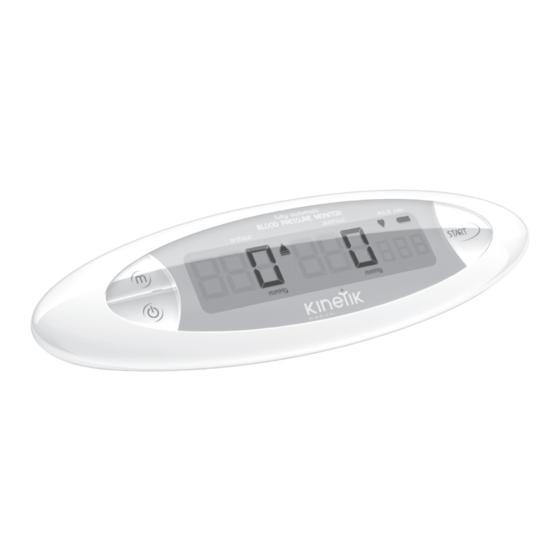
Table of Contents
Advertisement
Advertisement
Table of Contents

Summary of Contents for Kinetik BPM I Series
- Page 1 By Paul Aylett at 11:53 am, Jun 05, 2012 User Manual BPM I Series...
-
Page 2: Table Of Contents
CONTENT Introduction Using your Blood Pressure Monitor 6-13 Your first test Parts Start Measuring Process Setting up your Blood Pressure Monitor Memory What the results mean Battery Loading Re-measuring Connecting the Cuff Shut Down Putting on the Cuff Interpretation of Blood Pressure Results Additional Information on Blood Pressure Specification Abnormality &... -
Page 3: Introduction
Introduction Thank you for buying and using the Kinetik Medical Fully Automatic Blood Pressure Monitor. This monitor is an easy to use and accurate way to measure your blood pressure. Before you start, it is important to read this instruction manual. -
Page 4: Parts
Parts low battery Pulse deflate to measure (deflate air in cuff) inflate to measure Systolic Diastolic Memory Cuff tubule socket Start Rubber tubule Cuff... -
Page 5: Setting Up Your Blood Pressure Monitor
Setting up your Blood Pressure Monitor Loading the Batteries a. Open the battery cover at the back of the monitor. If using an external power supply, b. Insert four “AAA” batteries, observing correct polarity. ensure that batteries are removed c. Close the battery cover. from battery compartment. -
Page 6: Putting On The Cuff
Setting up your Blood Pressure Monitor Putting on the Cuff a. Place the cuff 1~2cm above the elbow joint. b. Place hand on a flat surface with the palm facing up and with the rubber tube running down the center of the arm. Measuring can be done on light clothing such as a shirt or blouse. -
Page 7: Using Your Blood Pressure Monitor
Using your Blood Pressure Monitor Your first test The British Hypertension Society (BHS) recommends that for your first test, you test both your arms. (Note: Ensure you do not suffer from any medical conditions which will prevent you from having your blood pressure measured in both arms). This will determine which arm should be used for future measurements. -
Page 8: Start
Using your Blood Pressure Monitor Start a. We recommend that you carry out you test whilst sitting at a table (ensuring the cuff is at the same height as your heart). This will place your arm and the monitor in an ideal position for the best results. b. -
Page 9: Measuring Process
Using your Blood Pressure Monitor Measuring Process a. Once the cuff has automatically inflated, the LCD screen will display “ ” whilst the pressure is gradually reduced and the monitor takes an automatic measurement. b. The monitor will beep when the automatic measurement has finished. If there is an error or abnormal reading, please refer to the“Abnormality &... -
Page 10: Memory
Using your Blood Pressure Monitor Memory The memory can store 60 sets of measurements. The results will be automatically stored. To check the last result, press “Memory” when the monitor is switched on and the most recently stored result will be displayed. Press “Memory”... -
Page 11: What The Results Mean
Using your Blood Pressure Monitor What the results mean a. The LCD screen will automatically display the systolic and diastolic pressure reading in mmHg and the pulse rate in pulse/min after each measurement. b. Record date, time, systolic reading, diastolic reading and pulse rate on your record card which you will find in the pack (including anything that may have influenced your blood pressure reading e.g. -
Page 12: Re-Measuring
Using your Blood Pressure Monitor Re-measuring If you want to measure again, just press the start button. Leave at least three minutes between measurements to allow blood circulation to the arm to return to normal. Do not measure your blood pressure too many times in one session as it may cause discomfort in the arm. -
Page 13: Interpretation Of Blood Pressure Results
Interpretation of Blood Pressure (BP) Results Systolic BP Diastolic BP Category of Blood Advice on Results (mmHg) (mmHg) Pressure Hypotension <100 <60 Practice a healthy lifestyle. Consult your doctor only if suffering symptoms of low BP (eg. fainting) Ideal <120 <80 Practice a healthy lifestyle. -
Page 14: Additional Information On Blood Pressure
Additional Information on Blood Pressure Your heart is just like a pump which works all the time to make the blood flow through all blood vessels. Blood pressure measures the force on the wall of the blood vessels caused by the pressure of the blood. -
Page 15: Specification
SPECIFICATION (1) Model: BPM I Series (12) Automatic power off: To be automatically cut off (2) Digital display system after 2minutes of not being use to save energy. (3) Measuring method: Oscillometric method (13) Battery life: Approx.2 months with 3 times usage per day... -
Page 16: Abnormality & Troubleshooting
Abnormality & Troubleshooting Abnormality Reason Action Pressure loss due to air leakage in Check the connection between the tube tube or cuff and monitor The cuff does not inflate or the display Rubber tube is not connected Reconnect the rubber tube properly shows low pressure during inflation properly Change the batteries - refer to the ‘Loading... -
Page 18: Blood Pressure Record Table
Blood Pressure Record Table Please log the date, time and your SYS (systolic) and DIA (Diastolic) blood pressure levels. We recommend you share this information with your Doctor...











Need help?
Do you have a question about the BPM I Series and is the answer not in the manual?
Questions and answers